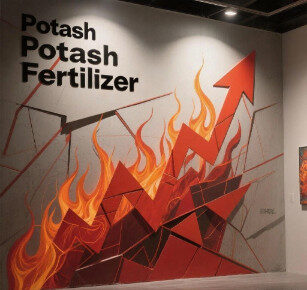In July 2025, China’s potash fertilizer market experienced a dramatic price surge, with potassium chloride (KCl) and potassium sulfate (SOP) prices climbing by 100–200 yuan per ton within a week. As of July 12, key market indicators revealed steep increases: Port 62% white KCl reached 3,450–3,600 yuan/ton (up 50–100 yuan); 60% large-grain red KCl hit 3,450–3,550 yuan/ton; Laotian white KCl rose to 3,250–3,350 yuan/ton; and 52% powdered SOP surged to 3,950–4,100 yuan/ton (up 100–150 yuan). This rapid escalation has sparked debate: Will prices continue to rise, or is a market correction imminent? Understanding the underlying dynamics is crucial to deciphering the future outlook.
Key Drivers Fueling the Price Surge
The current rally is underpinned by interlinked factors:
1. Supply Crunch and Inventory Depletion
Domestic port inventories of imported potassium chloride (KCl) plummeted below 200,000 tons—an all-time low—while major producers like Qinghai Salt Lake underwent maintenance shutdowns, further tightening the domestic supply. Geopolitical tensions and logistical bottlenecks also hindered imports from key suppliers, such as Russia and Belarus, exacerbating shortages.
2. Global Price Inflation
China’s 2025 potash contract price increased by 27%, reaching $346/ton (CFR), which directly escalated domestic costs. Simultaneously, Brazil’s robust soybean planting season drove global KCl prices to $360-$370/ton (CFR), putting upward pressure on Chinese imports.
3. Pre-Autumn Demand Spike
Anticipation of the peak fertilization season caused farmers and distributors to panic buy, intensifying competition for dwindling supplies. However, SOP producers faced a cost squeeze. Rising KCl prices eroded their profit margins, forcing them to raise downstream prices—a delicate balancing act between survival and market resistance.
Outlook: Short-Term Momentum vs. Long-Term Uncertainties
Short Term (July–August 2025): Bullish momentum
Low port inventories and limited domestic production encourage traders to withhold sales, anticipating additional price increases. Global price trends, especially in Brazil and Southeast Asia, will likely dictate China’s domestic trajectory. However, there is a critical risk: if prices spiral uncontrollably, Beijing may intervene by releasing state reserves or adjusting trade policies to stabilize the market.
Mid-to-Long Term (Q4 2025+): Potential Stabilization or Correction
Long-term dynamics offer mixed signals. China’s investment in Laos, led by firms such as Asia-Potash International, aims to reduce import dependency by increasing local production. Additionally, global capacity expansions (e.g., BHP’s Jansen project in Canada and resumed output from Russia and Belarus post-maintenance) could ease shortages by 2026. However, demand may normalize after the autumn fertilization period, which could weaken price momentum.
Market Sentiment and Behavioral Trends
Traders and buyers exhibit contrasting strategies: Speculators hoard stocks, betting on continued appreciation, while downstream producers (e.g., compound fertilizer makers) resist high prices and delay purchases in hopes of a price drop. SOP producers are on the brink: with 52% of SOP priced at 4,100 yuan per ton, some plants are operating at a loss and risking shutdowns if costs escalate further. This polarization underscores market volatility.
Conclusion: A Balancing Act
In the next one to two months, prices are likely to remain stable or increase, driven by limited inventory, strong global markets, and seasonal demand. However, stabilization or a retreat is plausible by late Q3/Q4 if:
- Laos-based supply ramps up significantly.
- The government intervenes through reserve releases or policy adjustments.
- Global potash production rebounds.
For buyers, strategic action is imperative.
- Secure urgent supplies now—prices may rise further before stabilizing.
- Monitor policy signals—stay vigilant for government interventions (e.g., reserve mobilization).
- Explore alternatives. If KCl/SOP costs become unsustainable, consider substitute fertilizers.
China’s potash market remains a “seller’s game” for now, but the sustainability of the rally hinges on global supply recovery and domestic policy shifts. All stakeholders must balance short-term urgency with long-term risk management.
Sources: China Potash Market Report (July 2025), Global Fertilizer Price Index, and Asia-Potash International Production Updates.









